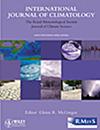Rainfall Variability in South America Modulated by the Central and Eastern Atlantic Niña Modes
Abstract
The present analysis examines the effects of the central Atlantic Niña (NCAN) and eastern Atlantic Niña (NEAN) modes on seasonal precipitation in South America (SA) and related atmospheric circulation during the 1951–2020 period. NCAN is the negative pole of broader Atlantic sea surface temperature (SST) modes: negative South Atlantic dipole (SAD) in all seasons, positive interhemispheric SST gradient (GRAD) in austral summer and autumn, and a weaker positive GRAD in winter. These modes modify the regional Hadley, intensifying the South American low-level jet in autumn, winter and spring. In all seasons, the NCAN mode modifies the regional Walker cell by positioning its descending branch in the central equatorial Atlantic. This branch may extend westward due to the coupling of the negative SST and positive pressure anomalies in the NCAN area (summer and spring) or the anomalous surface warming in the eastern tropical Pacific (winter). Precipitation anomalies feature a dipole between northern (positive values) and northeastern (negative values) SA in summer and autumn and in the other seasons, negative values in northern SA and localised positive values south of 20° S in winter and in the 10° S–25° S band in spring. The NEAN modes have limited influence on the regional atmospheric circulation during summer and spring. But during autumn (winter), the regional anomalous Walker and Hadley cells associated with a negative (positive) GRAD mode and a negative SAD mode modulate the precipitation variability through wind changes. The GRAD mode with reversed polarity from autumn to winter explains the near-reversed dipole precipitation anomaly patterns in tropical SA. The smallest (largest) differences in the seasonal precipitation anomalies between the NCAN and NEAN occur in winter (autumn). Since previous works did not distinguish the longitudinal position of the maximum SST anomalies, the present findings could be relevant for climate monitoring and modelling efforts.


 求助内容:
求助内容: 应助结果提醒方式:
应助结果提醒方式:


